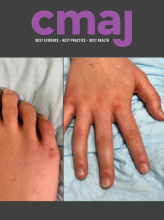Jump to comment:
- Page navigation anchor for RE: SURGICAL MASKS AND COVID-19 IN CANADARE: SURGICAL MASKS AND COVID-19 IN CANADA
The COVID-19 pandemic has resulted in a world-wide shortage of N95 respirators.
Healthcare workers are at increased risk of occupational exposure to SARS-CoV-2. The infection rate for healthcare workers was approximately 21% for SARS in 2003, and 29% in Wuhan in 2020. Public Health has determined the mode of transmission of COVID-19 to be mainly through droplets and contact. Current beliefs are that the evaporated droplets are not a significant source of COVID-19 infection. Personal protective equipment for droplet transmission includes eye and respiratory protection. Various authorities recommend the use of surgical masks for respiratory protection.
Surgical masks were originally meant to keep the surgical field clean, and were not meant as personal protective equipment.
The current surgical mask consists of 3 plies. The outer ply is made with a fluid-resistant material, the middle is the filtration medium (polypropylene sheet), and the inner layer is to absorb moisture produced by the wearer.
Surgical masks are classified as a Class 1 medical devices by Health Canada.
https://www.canada.ca/en/health-canada/services/drugs-health-products/co...
Unlike respirators, there is no requirement to print any label, name of the manufacturers, or test methods on the mask. By visual inspection, ther...
Show MoreCompeting Interests: None declared.References
- Josh Ng-Kamstra, Henry T. Stelfox, Kirsten Fiest, et al. Perspectives on personal protective equipment in acute care facilities during the COVID-19 pandemic. CMAJ 2020;192:E805-E809.
- ASTM F2100-19e1, Standard Specification for Performance of Materials Used in Medical Face Masks. ASTM International. https://www.astm.org/Standards/F2100.htm. Published: 2019. Accessed: September 25, 2020. DOI: 10.1520/F2100-19E01
- Bartoszko JJ, Farooqi MAM, Alhazzani W, Loeb M. Medical masks vs N95 respirators for preventing COVID-19 in healthcare workers: A systematic review and meta-analysis of randomized trials. Influenza Other Respir Viruses. 2020;14(4):365-373. doi:10.1111/
- World Health Organization. Rational use of personal protective equipment for coronavirus disease (COVID-19) and considerations during severe shortages - Interim guidance. https://www.who.int/publications/i/item/rational-use-of-personal-protective-equip
- Authorized medical devices for uses related to COVID-19: List of authorized medical devices other than testing devices. Government of Canada. https://www.canada.ca/en/health-canada/services/drugs-health-products/covid19-industry/medical-devices/authori
- Page navigation anchor for RE: Chinese SARS-CoV-2 Protective Measures and Healthcare Worker Infection Experience Compared to the Ontario ExperienceRE: Chinese SARS-CoV-2 Protective Measures and Healthcare Worker Infection Experience Compared to the Ontario Experience
Ng-Kamstra et al.(1) provide two references(2,3) to support their conclusion that, despite “complex and extensive” protective measures, “thousands of health care workers acquired the virus” in China. They then go to imply that such protective measures would not be effective if adopted in Canada. One of the two references(3) describes the difficulties experienced during the early stages of the pandemic in China; the other(2) actually reports success in preventing Chinese HCW infections - quite the opposite of Ng-Kamstra et al.’s characterization.
Specifically, Wang et al.(3) report that by February 24 there were 2,055 HCWs infected comprising 2.6% of all confirmed infections in China. Most of these infections occurred between January 18 – February 5. Wang et al. attributed the early infections to inadequate personal protection, intense workloads and extended shifts, shortages of personal protective equipment, and inadequate training. On January 20th the Chinese government designated the level of protective measures to control the SARS-CoV-2 virus as those prescribed for a Class A infectious disease (i.e. cholera and plague), even though COVID-19 was classified as a Class B infectious disease(4). A later report(5) put the confirmed number of HCW infections at 2,457 workers (3% of all confirmed cases up to March 26) including 17 deaths.
The protective measures listed in the Handbook(2) which Ng-Kamstra et al. characterized as being “complex and extensive...
Show MoreCompeting Interests: None declared.References
- , . RE: Chinese SARS-CoV-2 Protective Measures and Healthcare Worker Infection Experience Compared to the Ontario Experience. 2020;:-.
- 2. The First Affiliated Hospital — Zhejiang University School of Medicine. Handbook of COVID-19 prevention and treatment. Hangzhou (China): The Jack Ma Foundation and Alibaba Foundation; 2020. Available: https://gmcc.alibabadoctor.com/prevention-manual/de
- 3. Wang J, Zhou M, Liu F. Reasons for healthcare workers becoming infected with novel coronavirus disease 2019 (COVID-19) in China. J Hosp Infect. 2020 Mar 6;1051.
- 4. 疾病预防控制局 [Bureau of Disease Control and Prevention], 中华人民共和国国家卫生健康委员会公告 [Announcement of the National Health Commission of the People’s Republic of China], 2020 No.1. Available: http://www.nhc.gov.cn/jkj/s7916/202001/44a3b8245e8049d2837a4f27529cd386.sh
- 5. Zheng L, Wang X, Zhou C, Liu Q, Li S, Sun Q, Wang M, Zhou Q, Wang W. Analysis of the infection status of the health care workers in Wuhan during the COVID-19 outbreak: A cross-sectional study. Clinical Infectious Diseases. 2020 May 15.











